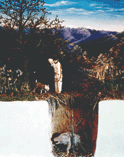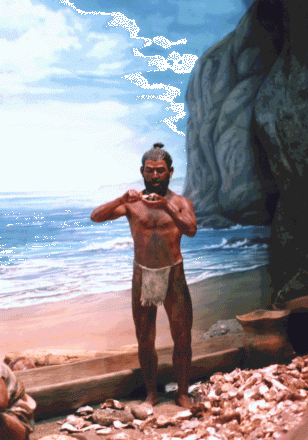Jomon Subsistence
The Japanese archipelago, with its four distinct seasons, would have provided a variety of different food resources at different times of the year. Analysis of the remains from the excavation of Jomon sites allows us to divide Jomon subsistence activities into three main categories:
I. Plant exploitation
II. Hunting
III. Marine resource exploitation
The dependence on any one of these resources was contingent on a variety of factors. One is where the people lived. For example, the large shell middens in the Kanto region, such as Kasori shell midden in Chiba Prefecture, are due to the fact that the Jomon inhabitants were close to the sea. Likewise, deer remains are quite common from Jomon sites in Nagano and Gunma prefectures, since these regions are heavily forested and are prime areas for deer and boar. Furthermore, it is also known that there were shifts in subsistence strategies throughout the Jomon period. For example, remains from theIncipient Jomon sites indicate that while some marine resources were exploited, there was a heavy dependence on the hunting of terrestrial mammal species.
I. Plant Exploitation
Today, in the Japanese archipelago, there are approximately 435 native plant species that humans can eat. To this number can be added the 120 species of mushroom that are edible for humans. In total, this would have provided the Jomon people a wide range of possible plant resources to eat.

A Jomon woman and her child collecting some of the various edible plants in the woodlands of Japan.
To date, over 58 species of plant remains have been recovered from Jomon sites. While this may seem small, it must be kept in mind that the acidic soil conditions of Japan do not often promote the preservation of organic materials. These remains include such plants as buckwheat, ferns, gourds, dogtooth violet, and mushrooms. By far, the most common remains though are nuts such as acorns, chestnuts, horse chestnuts and walnuts.
While there is an abundance of edible plants native to Japan, it must be kept in mind that they only have seasonal availability. Some plant resources, such as ferns, are only edible as shoots or young plants; thus, they would have only been available in the spring. Fruits and gourds would have only been available in the summer, while nuts are only available in the fall. ![[Jomon women preparing acorns.]](/eng/images/subsis03.jpg)
This seasonal availability forced the Jomon to develop resource scheduling and storage. While we do not have much solid evidence for scheduling acitivities, it is clear that the Jomon knew that food resources were available only at set times. Shellfish seem to be exploited primarily in the spring, deer were hunted primarily in the fall and winter. The plant remains indicate that they were aware of when they were in season also. Storage pits are common atMiddle Jomon period sites in eastern Honshu. Based on the remains found in them, they were used primarily to store nuts. It is possible that the Jomon people, particularly during the Middle Jomon period, developed agriculture or practiced horticulture. Evidence from Sannai Maruyama and elsewhere indicates the purposeful tending of chestnut trees and the clearing of other vegetation away from them. The numerous axes and ground stone tools are seen as being used to dig up tubers and roots. Many of these occur at sites in Nagano Prefecture, a region that is heavily wooded. Tubers and roots do not grow well in forested areas; Imamura and others have hypothesized that the forest was cleared so that tubers and roots could grow more plentiful.
Jomon women preparing acorns
II. Hunting
The most commonly hunted animals were the shika deer and the wild boar. Both of these animals would have supplied a large quantity of meat. Analysis of the faunal remains indicate that deer were hunted primarily during the winter, while boar were hunted year round. Smaller animals, such as flying squirrels, foxes, monkeys, and rabbits were also hunted.
Bows and arrows were used by the Jomon people to hunt and kill their prey. Dogs and pit traps were also utilized in hunting. Pit traps were quite common from the Incipient through Early Jomon sub-periods. Over 10,000 have been found in association with Earliest Jomon settlements in the Tama Hills region outside of Tokyo. during these sub-periods though, pit-traps seem to be arranged in a haphazard fashion; it seems the animal was intended to casually fall into the trap. The number of pit-traps decreases for the rest of the Jomon period, but they are usually laid out in a linear fashion. The presence of posts between them suggests that fences were used and the animals were possibly driven into the trap.

Model of a Jomon pit trap. Note the dog, to the left of the man helping in the hunt.
The Jomon had only one domesticated animal--the dog. Jomon dogs were probably used in hunting, and as possible pack animals. They were not eaten by the Jomon people. The dog was probably considered an important member of Jomon society since numerous dog burials have been excavated.
Like the Mesolithic inhabitants of Scotland, there is some evidence that the Jomon experimented with domesticating animals. Boars are not native to the Izu islands or Sado island. Before 7000 BC, boar remains are not found in the Izu islands. After this date, boar remains are found at Jomon sites in the Izu islands. Since boars are poor swimmers, it is clear that the Jomon brought the boar with them to the Izu islands. A similiar situation occurred for Sado island.
III. Marine resources
Shell middens are a common type of site found primarily in the Kanto region and in Hokkaido. These sites are large accumulations of shells from shellfish collecting activities. Clams, cockles, limpets and oysters were just a few of the species eaten by the Jomon people. Analysis of the shells from numerous middens indicates that the Jomon exploited over 350 species of shellfish. Microscopic study of the growth rings indicates that most of the shellfish were gathered during the spring.
 The large size of some of these shell middens has led scholars to speculate on whether or not there was a trade in shellfish meat. Chiba Prefecture, where many of the larger shell middens are located, has no stone resources. Yet, there are numerous stone tools at Jomon sites in this prefecture. This has led some archaeologists to theorize that shellfish meat, after salting or smoking, was traded to inland regions for stone, such as chert and obsidian.
The large size of some of these shell middens has led scholars to speculate on whether or not there was a trade in shellfish meat. Chiba Prefecture, where many of the larger shell middens are located, has no stone resources. Yet, there are numerous stone tools at Jomon sites in this prefecture. This has led some archaeologists to theorize that shellfish meat, after salting or smoking, was traded to inland regions for stone, such as chert and obsidian.
Fishing was also an important activity. Fish bones, such as tuna, salmon and bonita, have been recovered from numerous shell middens and other contexts. A variety of fish hooks and barbed bone spear points, net fragments and net sinkers have also been recovered. Bones of whales, turtles, seals and dolphins have been recovered from shell middens too. This indicates that they were also part of the diet of the Jomon people.
The start of a shell midden.
| <back to index | references> |
 English (UK)
English (UK)  Ру́сский
Ру́сский  中文
中文  Portugues
Portugues  한국어
한국어  Espanol
Espanol  Deutsch
Deutsch